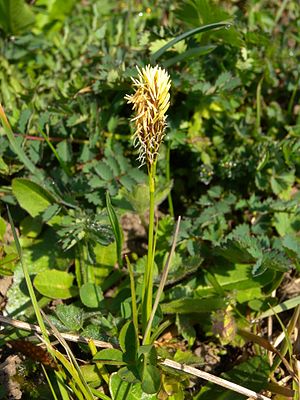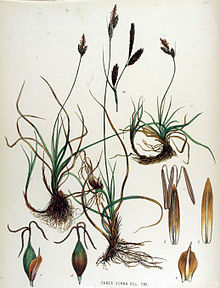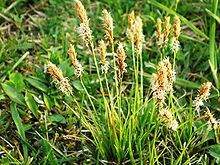Spring sedge
| Spring sedge | ||||||||||||
|---|---|---|---|---|---|---|---|---|---|---|---|---|

Spring sedge ( Carex caryophyllea ) |
||||||||||||
| Systematics | ||||||||||||
|
||||||||||||
| Scientific name | ||||||||||||
| Carex caryophyllea | ||||||||||||
| Latourr. |
The spring sedge ( Carex caryophyllea Latourr. , Syn .: Carex verna Chaix ) is a type of plant from the genus of the sedges within the sour grass family (Cyperaceae). It occurs in Europe and Western Siberia .
description
Vegetative characteristics
The spring sedge grows as a perennial herbaceous plant and reaches heights of 10 to 30 centimeters. It forms short, underground runners through which vegetative reproduction takes place. Young roots have a characteristic yellow tip.
The leaves are divided into leaf sheath and leaf blade. The brown leaf sheath is short. The dark green leaf blade is 1 to 3 mm wide, slightly folded in two and runs into a characteristic triangular tip. The previous year's leaf sheaths disintegrate into gray-brown fibers, but do not form a noticeable tuft of fibers.
Generative characteristics
The inflorescence is up to 3 cm long. The spring sedge is a variegated sedge. It forms a terminal male spikelet at the tip , which is blunt at the top , and below it one to four female spikelets. The lowest bract of the inflorescence usually has only a very short blade and the associated leaf sheath is at most 5 mm long. The brown husks have a light central nerve and no whitish skin edge. The 2.5 to 3 mm long tubes are densely hairy. There are three scars.
The number of chromosomes is 2n = 62, 64, 66 or 68.
ecology
The spring sedge is a hemicryptophyte or geophyte .
The flowering period extends from March to May. The utriculi have an elaiosome for ants to spread , and there is also spreading as rain drift and digestive spread .
Occurrence and endangerment
Carex caryophyllea is common in Europe and Asia to Japan. It is rarely found in the Central European lowlands , otherwise it occurs scattered in Central Europe . In the Alps it rises to altitudes above 2300 meters. In the Allgäu Alps, it rises in the Vorarlberg part between Hochtannberg and Widderstein up to 1850 meters above sea level.
The Basenholde Carex caryophyllea colonizes mainly dry and semi-arid grasslands , low- grade silicate grasslands , dwarf shrub heaths and grasslands and fresh meadows and pastures, as well as open forests and bushes. The spring sedge needs moderately base-rich, but loose and often sandy soil , which does not necessarily have to be calcareous and which can even be slightly acidic. It does not tolerate fertilization with nitrogen . It requires warmth in summer and lots of light all year round. It is a weak Kennart the phytosociological order Brometalia erecti and has its center of gravity deposits mainly in association Mesobromion erecti or caeruleae Molinion.
In some German federal states, the spring sedge is on the red list .
Systematics
One can distinguish the following varieties:
- Carex caryophyllea var. Caryophyllea : It occurs in the temperate zones of Eurasia.
- Carex caryophyllea var. Microtricha (Franch.) Kük. : It occurs in Far Eastern Asiatic Russia, northern Korea, and central and northern Japan.
Ornamental plant
The spring sedge is also used as an ornamental plant for rock gardens and plant troughs as well as for extensive roof greening , for example the cultivar 'The Beatles'.
swell
literature
- Eckehart J. Jäger, Klaus Werner (Ed.): Excursion flora from Germany . Founded by Werner Rothmaler. 10th edited edition. tape 4 : Vascular Plants: Critical Volume . Elsevier, Spektrum Akademischer Verlag, Munich / Heidelberg 2005, ISBN 3-8274-1496-2 .
- E. Foerster: Sedges, rushes, ledges and other mock grasses of grassland - a key to determining in the flowerless state. Manuscript, Kleve-Kellen March 1982.
- Dietmar Aichele, Heinz-Werner Schwegler: Our grasses. Sweet grasses, sour grasses, rushes . 11th edition. Kosmos, Stuttgart 1998, ISBN 3-440-07613-X .
- Spring sedge. In: FloraWeb.de. (Sections Description, Ecology and Distribution)
Individual evidence
- ↑ a b c d e f Spring sedge. In: FloraWeb.de.
- ^ Erich Oberdorfer : Plant-sociological excursion flora for Germany and neighboring areas . With the collaboration of Angelika Schwabe and Theo Müller. 8th, heavily revised and expanded edition. Eugen Ulmer, Stuttgart (Hohenheim) 2001, ISBN 3-8001-3131-5 , pp. 186 .
- ↑ a b Ruprecht Düll , Herfried Kutzelnigg : Pocket dictionary of the plants of Germany and neighboring countries. The most common Central European species in portrait . 7th, corrected and enlarged edition. Quelle & Meyer, Wiebelsheim 2011, ISBN 978-3-494-01424-1 .
- ↑ a b c d Rafaël Govaerts (Ed.): Carex caryophyllea. In: World Checklist of Selected Plant Families (WCSP) - The Board of Trustees of the Royal Botanic Gardens, Kew . Retrieved October 18, 2016.
- ↑ a b c d e Dietmar Aichele, Heinz-Werner Schwegler: The flowering plants of Central Europe . 2nd Edition. tape 5 : Swan flowers to duckweed plants . Franckh-Kosmos, Stuttgart 2000, ISBN 3-440-08048-X , p. 279 .
- ↑ Erhard Dörr, Wolfgang Lippert : Flora of the Allgäu and its surroundings. Volume 1, IHW, Eching 2001, ISBN 3-930167-50-6 , p. 264.
- ↑ Bernd Hertle, Peter Kiermeier, Marion Nickig: Garden flowers. The large GU PraxisHandbuch. Gräfe and Unzer, Munich 2008, ISBN 978-3-8338-0704-6 , p. 227 ( limited preview in the Google book search).
Web links
- Spring sedge . In: BiolFlor, the database of biological-ecological characteristics of the flora of Germany.
- Profile and distribution map for Bavaria . In: Botanical Information Hub of Bavaria .
- Carex caryophyllea Latourr. In: Info Flora , the national data and information center for Swiss flora .
- Distribution in the northern hemisphere from: Eric Hultén, Magnus Fries: Atlas of North European vascular plants. 1986, ISBN 3-87429-263-0 at Den virtuella floran. (swed.)
- Thomas Meyer: Data sheet with identification key and photos at Flora-de: Flora von Deutschland (old name of the website: Flowers in Swabia )
- Data sheet with links to photos.
- Data sheet with photos.
- Data sheet with photos.


